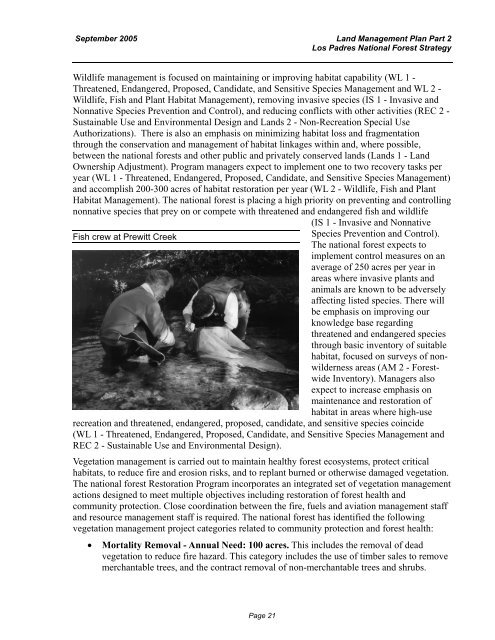Land Management Plan - Part 2 Los Padres National Forest Strategy
Land Management Plan - Part 2 Los Padres National Forest Strategy
Land Management Plan - Part 2 Los Padres National Forest Strategy
Create successful ePaper yourself
Turn your PDF publications into a flip-book with our unique Google optimized e-Paper software.
September 2005 <strong>Land</strong> <strong>Management</strong> <strong>Plan</strong> <strong>Part</strong> 2<br />
<strong>Los</strong> <strong>Padres</strong> <strong>National</strong> <strong>Forest</strong> <strong>Strategy</strong><br />
Wildlife management is focused on maintaining or improving habitat capability (WL 1 -<br />
Threatened, Endangered, Proposed, Candidate, and Sensitive Species <strong>Management</strong> and WL 2 -<br />
Wildlife, Fish and <strong>Plan</strong>t Habitat <strong>Management</strong>), removing invasive species (IS 1 - Invasive and<br />
Nonnative Species Prevention and Control), and reducing conflicts with other activities (REC 2 -<br />
Sustainable Use and Environmental Design and <strong>Land</strong>s 2 - Non-Recreation Special Use<br />
Authorizations). There is also an emphasis on minimizing habitat loss and fragmentation<br />
through the conservation and management of habitat linkages within and, where possible,<br />
between the national forests and other public and privately conserved lands (<strong>Land</strong>s 1 - <strong>Land</strong><br />
Ownership Adjustment). Program managers expect to implement one to two recovery tasks per<br />
year (WL 1 - Threatened, Endangered, Proposed, Candidate, and Sensitive Species <strong>Management</strong>)<br />
and accomplish 200-300 acres of habitat restoration per year (WL 2 - Wildlife, Fish and <strong>Plan</strong>t<br />
Habitat <strong>Management</strong>). The national forest is placing a high priority on preventing and controlling<br />
nonnative species that prey on or compete with threatened and endangered fish and wildlife<br />
(IS 1 - Invasive and Nonnative<br />
Fish crew at Prewitt Creek<br />
Species Prevention and Control).<br />
The national forest expects to<br />
implement control measures on an<br />
average of 250 acres per year in<br />
areas where invasive plants and<br />
animals are known to be adversely<br />
affecting listed species. There will<br />
be emphasis on improving our<br />
knowledge base regarding<br />
threatened and endangered species<br />
through basic inventory of suitable<br />
habitat, focused on surveys of nonwilderness<br />
areas (AM 2 - <strong>Forest</strong>wide<br />
Inventory). Managers also<br />
expect to increase emphasis on<br />
maintenance and restoration of<br />
habitat in areas where high-use<br />
recreation and threatened, endangered, proposed, candidate, and sensitive species coincide<br />
(WL 1 - Threatened, Endangered, Proposed, Candidate, and Sensitive Species <strong>Management</strong> and<br />
REC 2 - Sustainable Use and Environmental Design).<br />
Vegetation management is carried out to maintain healthy forest ecosystems, protect critical<br />
habitats, to reduce fire and erosion risks, and to replant burned or otherwise damaged vegetation.<br />
The national forest Restoration Program incorporates an integrated set of vegetation management<br />
actions designed to meet multiple objectives including restoration of forest health and<br />
community protection. Close coordination between the fire, fuels and aviation management staff<br />
and resource management staff is required. The national forest has identified the following<br />
vegetation management project categories related to community protection and forest health:<br />
• Mortality Removal - Annual Need: 100 acres. This includes the removal of dead<br />
vegetation to reduce fire hazard. This category includes the use of timber sales to remove<br />
merchantable trees, and the contract removal of non-merchantable trees and shrubs.<br />
Page 21
















